MMM240: Reflective Journal on Leadership, Motivation & Teamwork
VerifiedAdded on 2022/08/26
|12
|2677
|36
Journal and Reflective Writing
AI Summary
This assignment comprises a reflective journal focusing on key topics in organizational behavior, including motivation in the contemporary workforce, managing behavior through learning, working and performing in groups and teams, and professional identity self-reflection. The journal entries delve into the learning, critique, and reflection aspects of each topic, emphasizing the importance of motivation, different types of motivation theories, and the role of job design in fostering employee engagement. It further explores behavioral, social, and cognitive learning theories and their application in managing workplace behavior. The significance of teamwork, the differences between groups and teams, and the impact of self-managed teams on organizational effectiveness are also discussed. The final journal entry provides a self-reflection on the student's professional identity, highlighting the skills and knowledge gained throughout the course and their applicability to future career endeavors. The student showcases an understanding of leadership, motivation, and team dynamics, emphasizing the importance of effective communication, cultural diversity, and self-motivation in achieving organizational excellence.
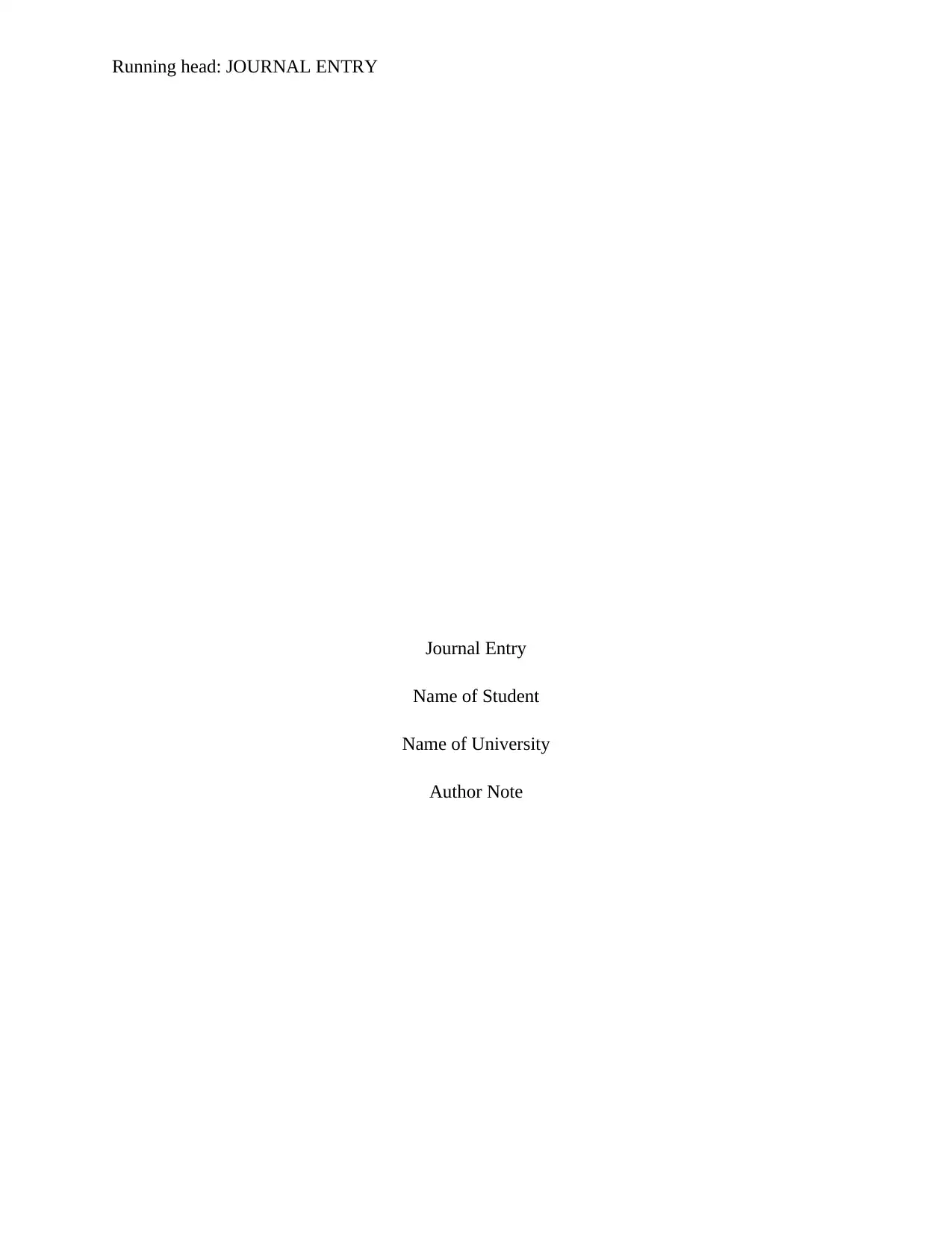
Running head: JOURNAL ENTRY
Journal Entry
Name of Student
Name of University
Author Note
Journal Entry
Name of Student
Name of University
Author Note
Paraphrase This Document
Need a fresh take? Get an instant paraphrase of this document with our AI Paraphraser
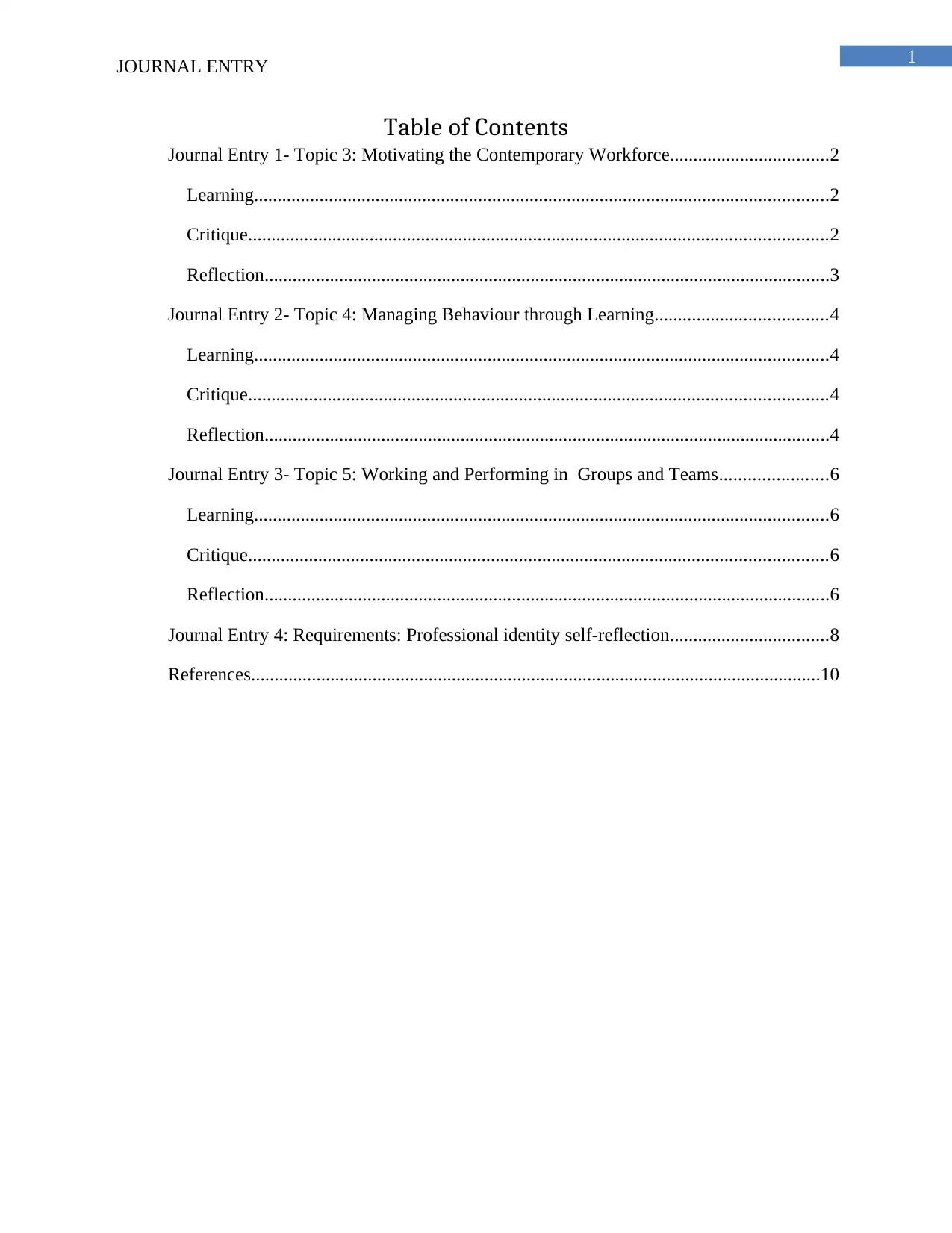
1
JOURNAL ENTRY
Table of Contents
Journal Entry 1- Topic 3: Motivating the Contemporary Workforce..................................2
Learning...........................................................................................................................2
Critique............................................................................................................................2
Reflection.........................................................................................................................3
Journal Entry 2- Topic 4: Managing Behaviour through Learning.....................................4
Learning...........................................................................................................................4
Critique............................................................................................................................4
Reflection.........................................................................................................................4
Journal Entry 3- Topic 5: Working and Performing in Groups and Teams.......................6
Learning...........................................................................................................................6
Critique............................................................................................................................6
Reflection.........................................................................................................................6
Journal Entry 4: Requirements: Professional identity self-reflection..................................8
References..........................................................................................................................10
JOURNAL ENTRY
Table of Contents
Journal Entry 1- Topic 3: Motivating the Contemporary Workforce..................................2
Learning...........................................................................................................................2
Critique............................................................................................................................2
Reflection.........................................................................................................................3
Journal Entry 2- Topic 4: Managing Behaviour through Learning.....................................4
Learning...........................................................................................................................4
Critique............................................................................................................................4
Reflection.........................................................................................................................4
Journal Entry 3- Topic 5: Working and Performing in Groups and Teams.......................6
Learning...........................................................................................................................6
Critique............................................................................................................................6
Reflection.........................................................................................................................6
Journal Entry 4: Requirements: Professional identity self-reflection..................................8
References..........................................................................................................................10
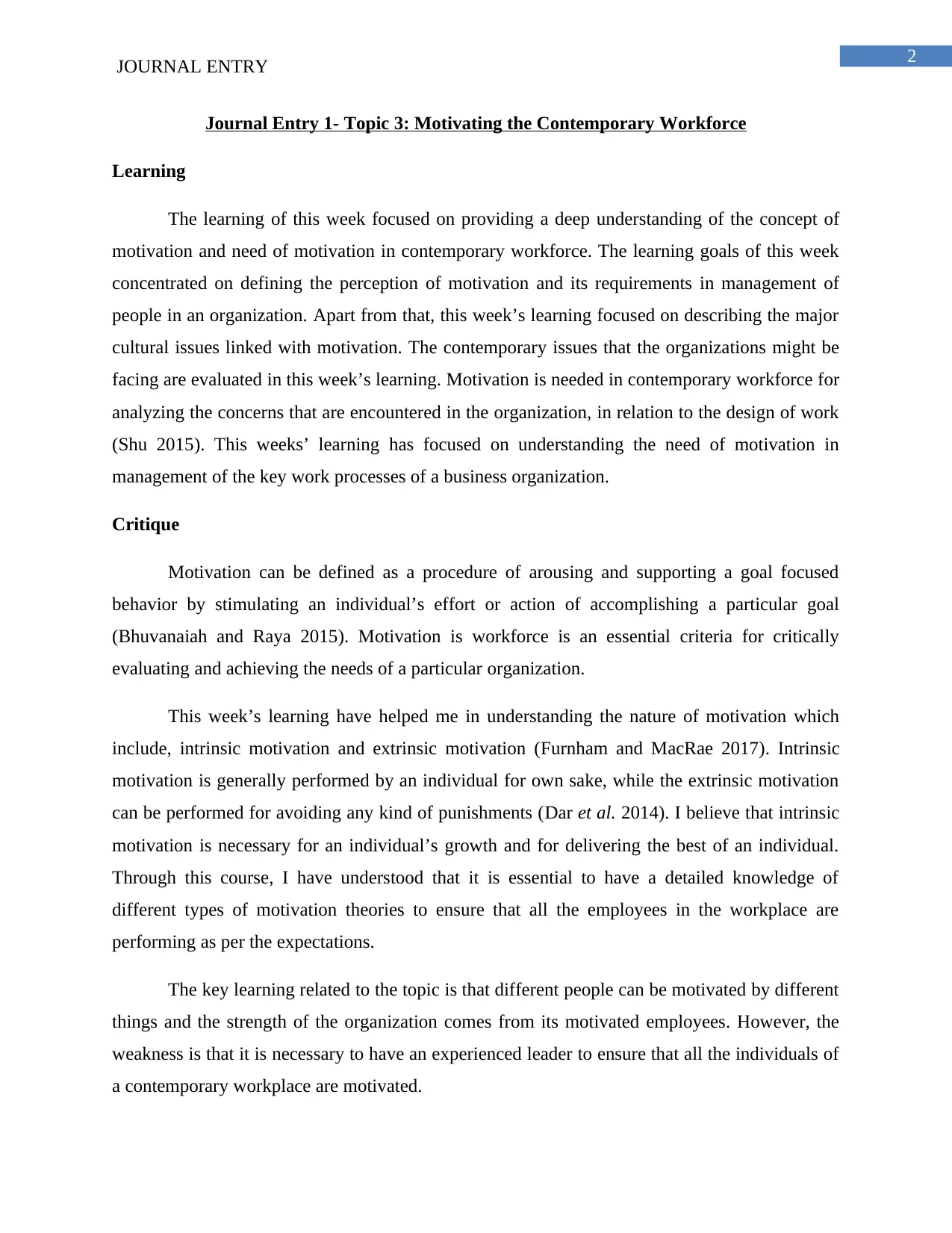
2
JOURNAL ENTRY
Journal Entry 1- Topic 3: Motivating the Contemporary Workforce
Learning
The learning of this week focused on providing a deep understanding of the concept of
motivation and need of motivation in contemporary workforce. The learning goals of this week
concentrated on defining the perception of motivation and its requirements in management of
people in an organization. Apart from that, this week’s learning focused on describing the major
cultural issues linked with motivation. The contemporary issues that the organizations might be
facing are evaluated in this week’s learning. Motivation is needed in contemporary workforce for
analyzing the concerns that are encountered in the organization, in relation to the design of work
(Shu 2015). This weeks’ learning has focused on understanding the need of motivation in
management of the key work processes of a business organization.
Critique
Motivation can be defined as a procedure of arousing and supporting a goal focused
behavior by stimulating an individual’s effort or action of accomplishing a particular goal
(Bhuvanaiah and Raya 2015). Motivation is workforce is an essential criteria for critically
evaluating and achieving the needs of a particular organization.
This week’s learning have helped me in understanding the nature of motivation which
include, intrinsic motivation and extrinsic motivation (Furnham and MacRae 2017). Intrinsic
motivation is generally performed by an individual for own sake, while the extrinsic motivation
can be performed for avoiding any kind of punishments (Dar et al. 2014). I believe that intrinsic
motivation is necessary for an individual’s growth and for delivering the best of an individual.
Through this course, I have understood that it is essential to have a detailed knowledge of
different types of motivation theories to ensure that all the employees in the workplace are
performing as per the expectations.
The key learning related to the topic is that different people can be motivated by different
things and the strength of the organization comes from its motivated employees. However, the
weakness is that it is necessary to have an experienced leader to ensure that all the individuals of
a contemporary workplace are motivated.
JOURNAL ENTRY
Journal Entry 1- Topic 3: Motivating the Contemporary Workforce
Learning
The learning of this week focused on providing a deep understanding of the concept of
motivation and need of motivation in contemporary workforce. The learning goals of this week
concentrated on defining the perception of motivation and its requirements in management of
people in an organization. Apart from that, this week’s learning focused on describing the major
cultural issues linked with motivation. The contemporary issues that the organizations might be
facing are evaluated in this week’s learning. Motivation is needed in contemporary workforce for
analyzing the concerns that are encountered in the organization, in relation to the design of work
(Shu 2015). This weeks’ learning has focused on understanding the need of motivation in
management of the key work processes of a business organization.
Critique
Motivation can be defined as a procedure of arousing and supporting a goal focused
behavior by stimulating an individual’s effort or action of accomplishing a particular goal
(Bhuvanaiah and Raya 2015). Motivation is workforce is an essential criteria for critically
evaluating and achieving the needs of a particular organization.
This week’s learning have helped me in understanding the nature of motivation which
include, intrinsic motivation and extrinsic motivation (Furnham and MacRae 2017). Intrinsic
motivation is generally performed by an individual for own sake, while the extrinsic motivation
can be performed for avoiding any kind of punishments (Dar et al. 2014). I believe that intrinsic
motivation is necessary for an individual’s growth and for delivering the best of an individual.
Through this course, I have understood that it is essential to have a detailed knowledge of
different types of motivation theories to ensure that all the employees in the workplace are
performing as per the expectations.
The key learning related to the topic is that different people can be motivated by different
things and the strength of the organization comes from its motivated employees. However, the
weakness is that it is necessary to have an experienced leader to ensure that all the individuals of
a contemporary workplace are motivated.
⊘ This is a preview!⊘
Do you want full access?
Subscribe today to unlock all pages.

Trusted by 1+ million students worldwide
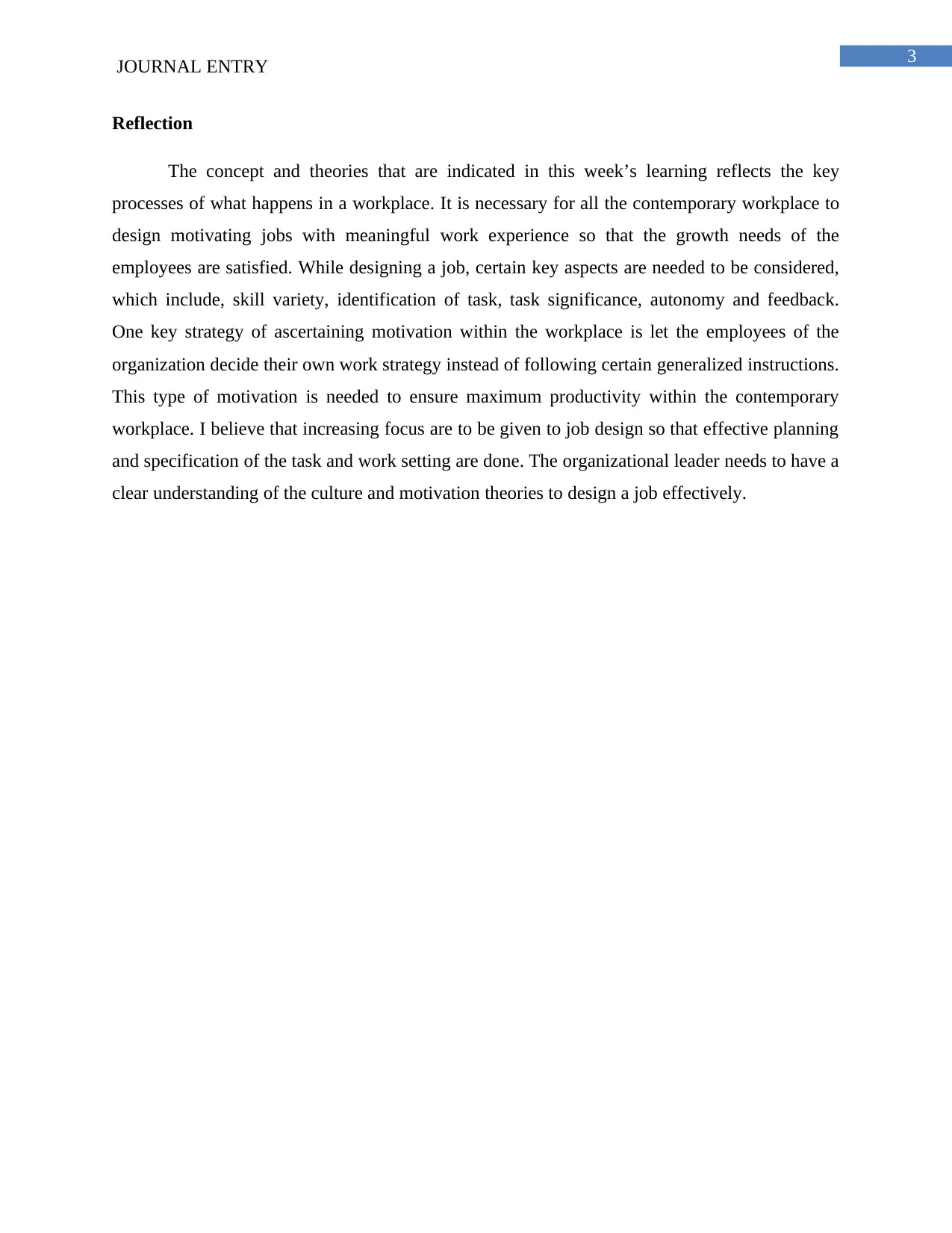
3
JOURNAL ENTRY
Reflection
The concept and theories that are indicated in this week’s learning reflects the key
processes of what happens in a workplace. It is necessary for all the contemporary workplace to
design motivating jobs with meaningful work experience so that the growth needs of the
employees are satisfied. While designing a job, certain key aspects are needed to be considered,
which include, skill variety, identification of task, task significance, autonomy and feedback.
One key strategy of ascertaining motivation within the workplace is let the employees of the
organization decide their own work strategy instead of following certain generalized instructions.
This type of motivation is needed to ensure maximum productivity within the contemporary
workplace. I believe that increasing focus are to be given to job design so that effective planning
and specification of the task and work setting are done. The organizational leader needs to have a
clear understanding of the culture and motivation theories to design a job effectively.
JOURNAL ENTRY
Reflection
The concept and theories that are indicated in this week’s learning reflects the key
processes of what happens in a workplace. It is necessary for all the contemporary workplace to
design motivating jobs with meaningful work experience so that the growth needs of the
employees are satisfied. While designing a job, certain key aspects are needed to be considered,
which include, skill variety, identification of task, task significance, autonomy and feedback.
One key strategy of ascertaining motivation within the workplace is let the employees of the
organization decide their own work strategy instead of following certain generalized instructions.
This type of motivation is needed to ensure maximum productivity within the contemporary
workplace. I believe that increasing focus are to be given to job design so that effective planning
and specification of the task and work setting are done. The organizational leader needs to have a
clear understanding of the culture and motivation theories to design a job effectively.
Paraphrase This Document
Need a fresh take? Get an instant paraphrase of this document with our AI Paraphraser
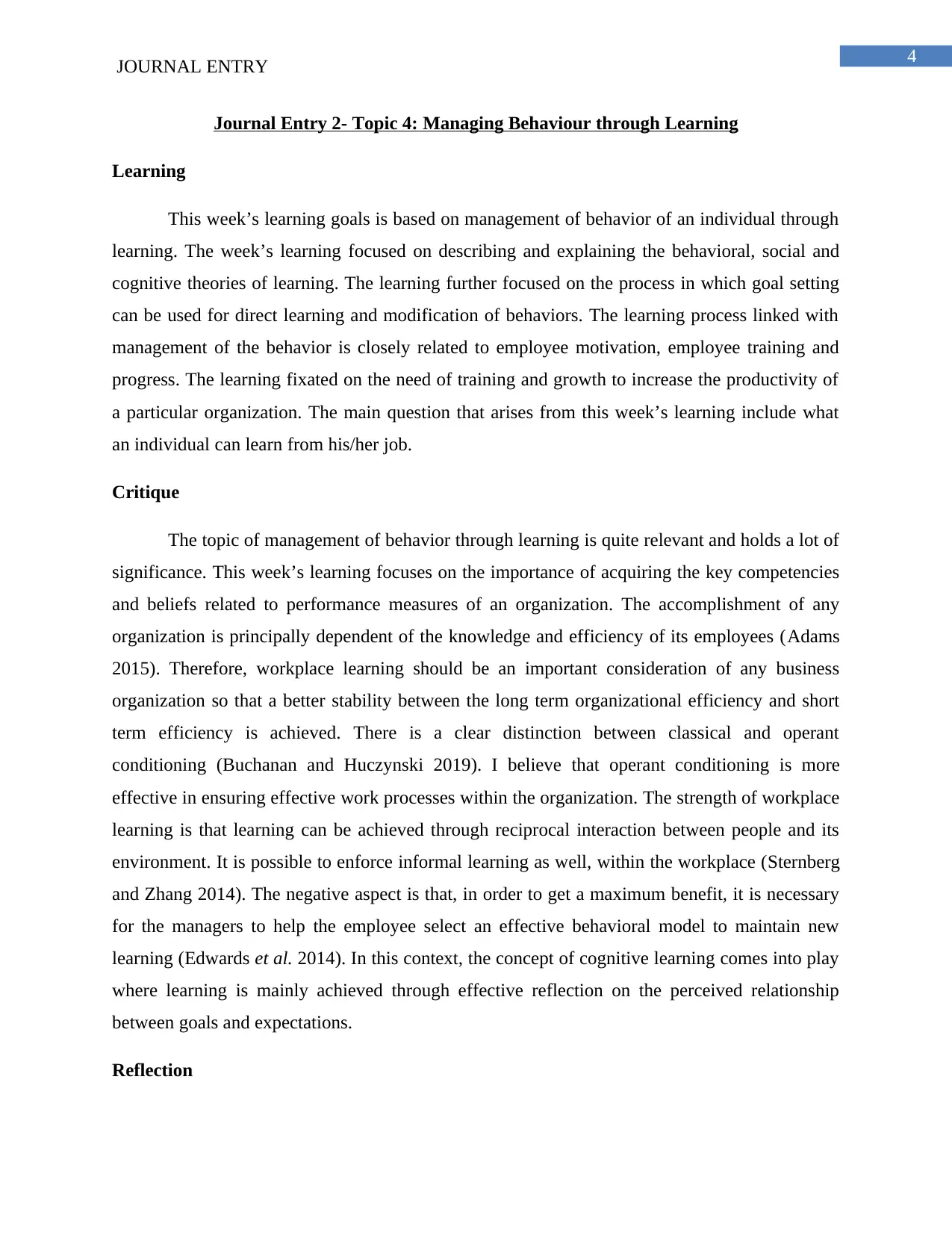
4
JOURNAL ENTRY
Journal Entry 2- Topic 4: Managing Behaviour through Learning
Learning
This week’s learning goals is based on management of behavior of an individual through
learning. The week’s learning focused on describing and explaining the behavioral, social and
cognitive theories of learning. The learning further focused on the process in which goal setting
can be used for direct learning and modification of behaviors. The learning process linked with
management of the behavior is closely related to employee motivation, employee training and
progress. The learning fixated on the need of training and growth to increase the productivity of
a particular organization. The main question that arises from this week’s learning include what
an individual can learn from his/her job.
Critique
The topic of management of behavior through learning is quite relevant and holds a lot of
significance. This week’s learning focuses on the importance of acquiring the key competencies
and beliefs related to performance measures of an organization. The accomplishment of any
organization is principally dependent of the knowledge and efficiency of its employees (Adams
2015). Therefore, workplace learning should be an important consideration of any business
organization so that a better stability between the long term organizational efficiency and short
term efficiency is achieved. There is a clear distinction between classical and operant
conditioning (Buchanan and Huczynski 2019). I believe that operant conditioning is more
effective in ensuring effective work processes within the organization. The strength of workplace
learning is that learning can be achieved through reciprocal interaction between people and its
environment. It is possible to enforce informal learning as well, within the workplace (Sternberg
and Zhang 2014). The negative aspect is that, in order to get a maximum benefit, it is necessary
for the managers to help the employee select an effective behavioral model to maintain new
learning (Edwards et al. 2014). In this context, the concept of cognitive learning comes into play
where learning is mainly achieved through effective reflection on the perceived relationship
between goals and expectations.
Reflection
JOURNAL ENTRY
Journal Entry 2- Topic 4: Managing Behaviour through Learning
Learning
This week’s learning goals is based on management of behavior of an individual through
learning. The week’s learning focused on describing and explaining the behavioral, social and
cognitive theories of learning. The learning further focused on the process in which goal setting
can be used for direct learning and modification of behaviors. The learning process linked with
management of the behavior is closely related to employee motivation, employee training and
progress. The learning fixated on the need of training and growth to increase the productivity of
a particular organization. The main question that arises from this week’s learning include what
an individual can learn from his/her job.
Critique
The topic of management of behavior through learning is quite relevant and holds a lot of
significance. This week’s learning focuses on the importance of acquiring the key competencies
and beliefs related to performance measures of an organization. The accomplishment of any
organization is principally dependent of the knowledge and efficiency of its employees (Adams
2015). Therefore, workplace learning should be an important consideration of any business
organization so that a better stability between the long term organizational efficiency and short
term efficiency is achieved. There is a clear distinction between classical and operant
conditioning (Buchanan and Huczynski 2019). I believe that operant conditioning is more
effective in ensuring effective work processes within the organization. The strength of workplace
learning is that learning can be achieved through reciprocal interaction between people and its
environment. It is possible to enforce informal learning as well, within the workplace (Sternberg
and Zhang 2014). The negative aspect is that, in order to get a maximum benefit, it is necessary
for the managers to help the employee select an effective behavioral model to maintain new
learning (Edwards et al. 2014). In this context, the concept of cognitive learning comes into play
where learning is mainly achieved through effective reflection on the perceived relationship
between goals and expectations.
Reflection
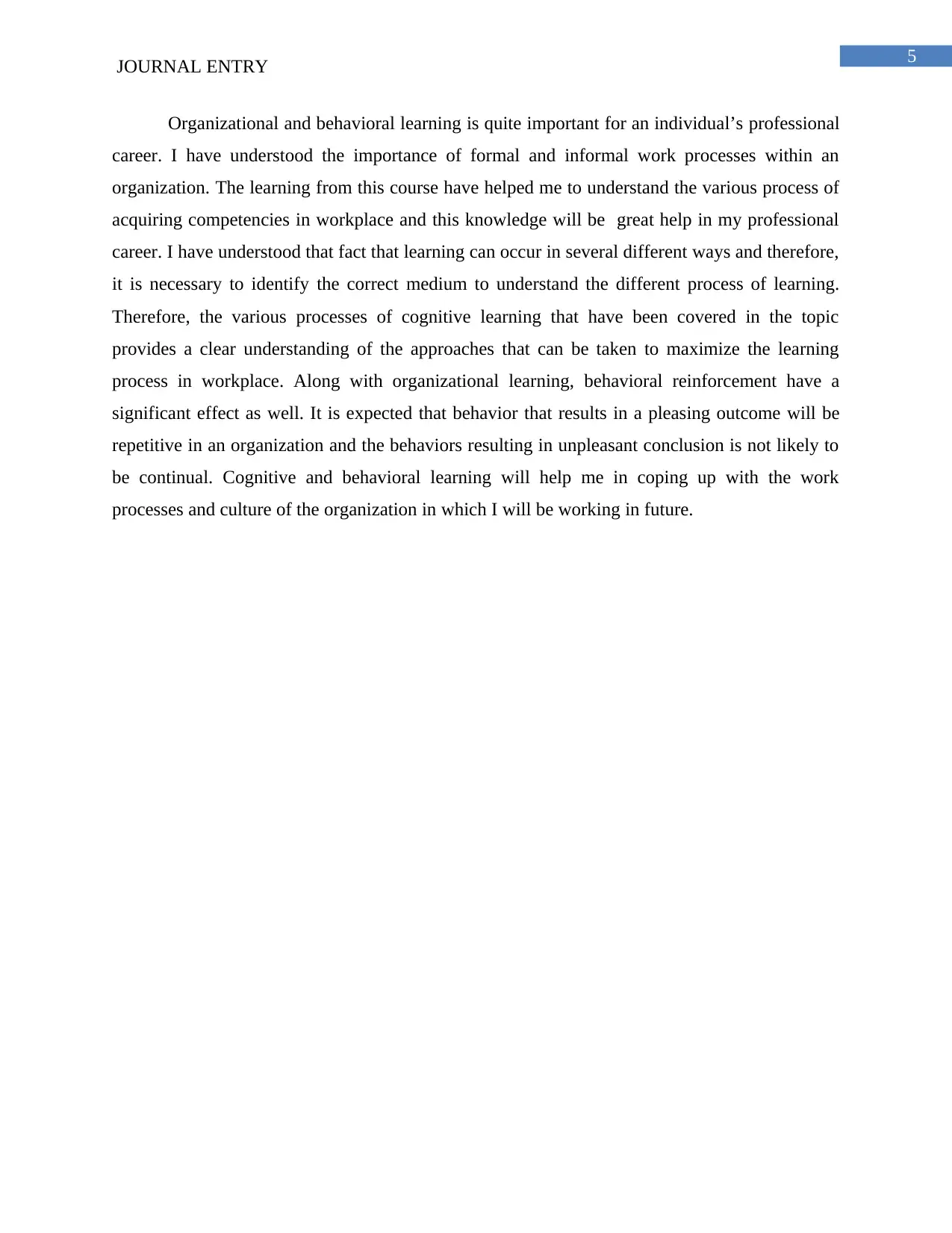
5
JOURNAL ENTRY
Organizational and behavioral learning is quite important for an individual’s professional
career. I have understood the importance of formal and informal work processes within an
organization. The learning from this course have helped me to understand the various process of
acquiring competencies in workplace and this knowledge will be great help in my professional
career. I have understood that fact that learning can occur in several different ways and therefore,
it is necessary to identify the correct medium to understand the different process of learning.
Therefore, the various processes of cognitive learning that have been covered in the topic
provides a clear understanding of the approaches that can be taken to maximize the learning
process in workplace. Along with organizational learning, behavioral reinforcement have a
significant effect as well. It is expected that behavior that results in a pleasing outcome will be
repetitive in an organization and the behaviors resulting in unpleasant conclusion is not likely to
be continual. Cognitive and behavioral learning will help me in coping up with the work
processes and culture of the organization in which I will be working in future.
JOURNAL ENTRY
Organizational and behavioral learning is quite important for an individual’s professional
career. I have understood the importance of formal and informal work processes within an
organization. The learning from this course have helped me to understand the various process of
acquiring competencies in workplace and this knowledge will be great help in my professional
career. I have understood that fact that learning can occur in several different ways and therefore,
it is necessary to identify the correct medium to understand the different process of learning.
Therefore, the various processes of cognitive learning that have been covered in the topic
provides a clear understanding of the approaches that can be taken to maximize the learning
process in workplace. Along with organizational learning, behavioral reinforcement have a
significant effect as well. It is expected that behavior that results in a pleasing outcome will be
repetitive in an organization and the behaviors resulting in unpleasant conclusion is not likely to
be continual. Cognitive and behavioral learning will help me in coping up with the work
processes and culture of the organization in which I will be working in future.
⊘ This is a preview!⊘
Do you want full access?
Subscribe today to unlock all pages.

Trusted by 1+ million students worldwide
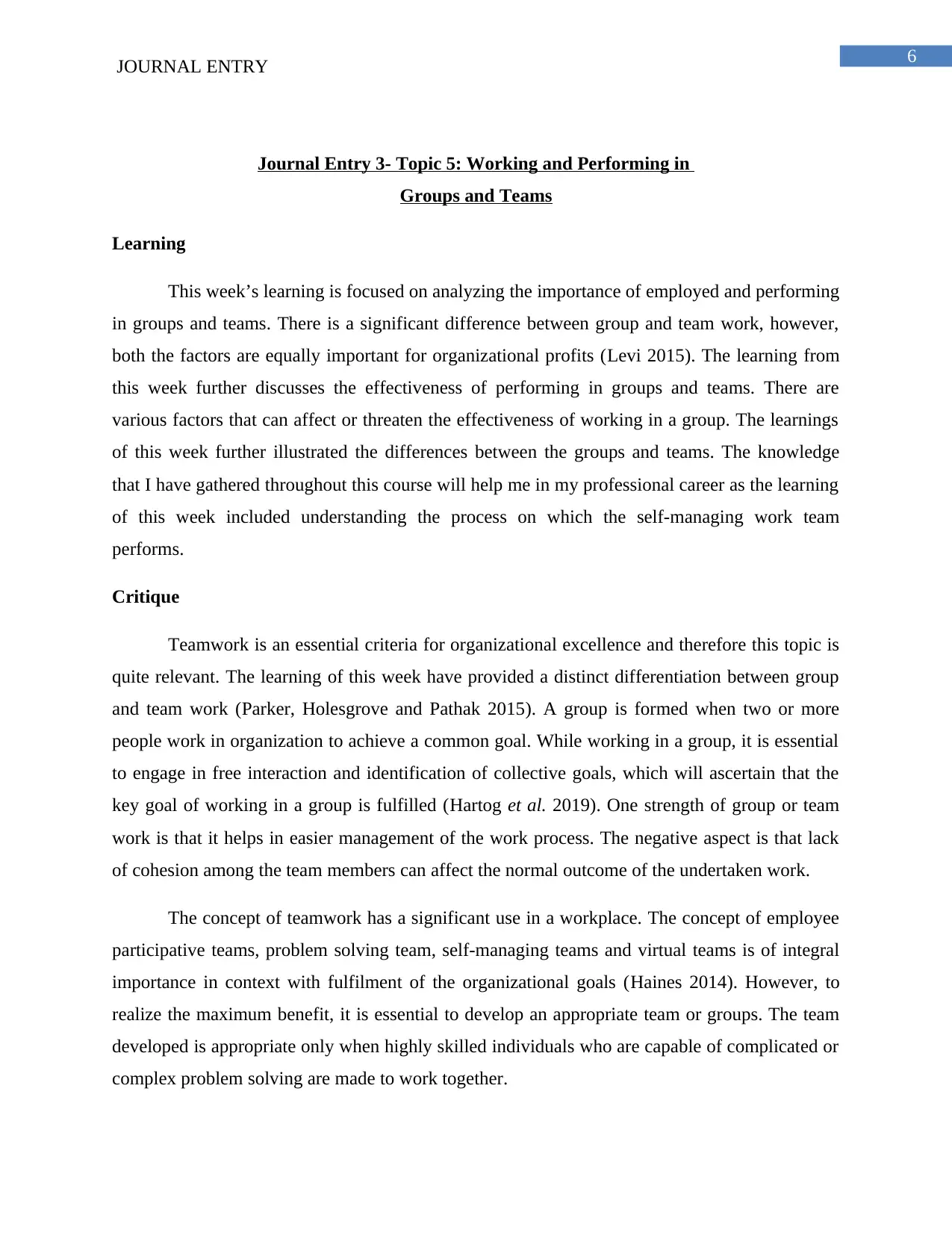
6
JOURNAL ENTRY
Journal Entry 3- Topic 5: Working and Performing in
Groups and Teams
Learning
This week’s learning is focused on analyzing the importance of employed and performing
in groups and teams. There is a significant difference between group and team work, however,
both the factors are equally important for organizational profits (Levi 2015). The learning from
this week further discusses the effectiveness of performing in groups and teams. There are
various factors that can affect or threaten the effectiveness of working in a group. The learnings
of this week further illustrated the differences between the groups and teams. The knowledge
that I have gathered throughout this course will help me in my professional career as the learning
of this week included understanding the process on which the self-managing work team
performs.
Critique
Teamwork is an essential criteria for organizational excellence and therefore this topic is
quite relevant. The learning of this week have provided a distinct differentiation between group
and team work (Parker, Holesgrove and Pathak 2015). A group is formed when two or more
people work in organization to achieve a common goal. While working in a group, it is essential
to engage in free interaction and identification of collective goals, which will ascertain that the
key goal of working in a group is fulfilled (Hartog et al. 2019). One strength of group or team
work is that it helps in easier management of the work process. The negative aspect is that lack
of cohesion among the team members can affect the normal outcome of the undertaken work.
The concept of teamwork has a significant use in a workplace. The concept of employee
participative teams, problem solving team, self-managing teams and virtual teams is of integral
importance in context with fulfilment of the organizational goals (Haines 2014). However, to
realize the maximum benefit, it is essential to develop an appropriate team or groups. The team
developed is appropriate only when highly skilled individuals who are capable of complicated or
complex problem solving are made to work together.
JOURNAL ENTRY
Journal Entry 3- Topic 5: Working and Performing in
Groups and Teams
Learning
This week’s learning is focused on analyzing the importance of employed and performing
in groups and teams. There is a significant difference between group and team work, however,
both the factors are equally important for organizational profits (Levi 2015). The learning from
this week further discusses the effectiveness of performing in groups and teams. There are
various factors that can affect or threaten the effectiveness of working in a group. The learnings
of this week further illustrated the differences between the groups and teams. The knowledge
that I have gathered throughout this course will help me in my professional career as the learning
of this week included understanding the process on which the self-managing work team
performs.
Critique
Teamwork is an essential criteria for organizational excellence and therefore this topic is
quite relevant. The learning of this week have provided a distinct differentiation between group
and team work (Parker, Holesgrove and Pathak 2015). A group is formed when two or more
people work in organization to achieve a common goal. While working in a group, it is essential
to engage in free interaction and identification of collective goals, which will ascertain that the
key goal of working in a group is fulfilled (Hartog et al. 2019). One strength of group or team
work is that it helps in easier management of the work process. The negative aspect is that lack
of cohesion among the team members can affect the normal outcome of the undertaken work.
The concept of teamwork has a significant use in a workplace. The concept of employee
participative teams, problem solving team, self-managing teams and virtual teams is of integral
importance in context with fulfilment of the organizational goals (Haines 2014). However, to
realize the maximum benefit, it is essential to develop an appropriate team or groups. The team
developed is appropriate only when highly skilled individuals who are capable of complicated or
complex problem solving are made to work together.
Paraphrase This Document
Need a fresh take? Get an instant paraphrase of this document with our AI Paraphraser
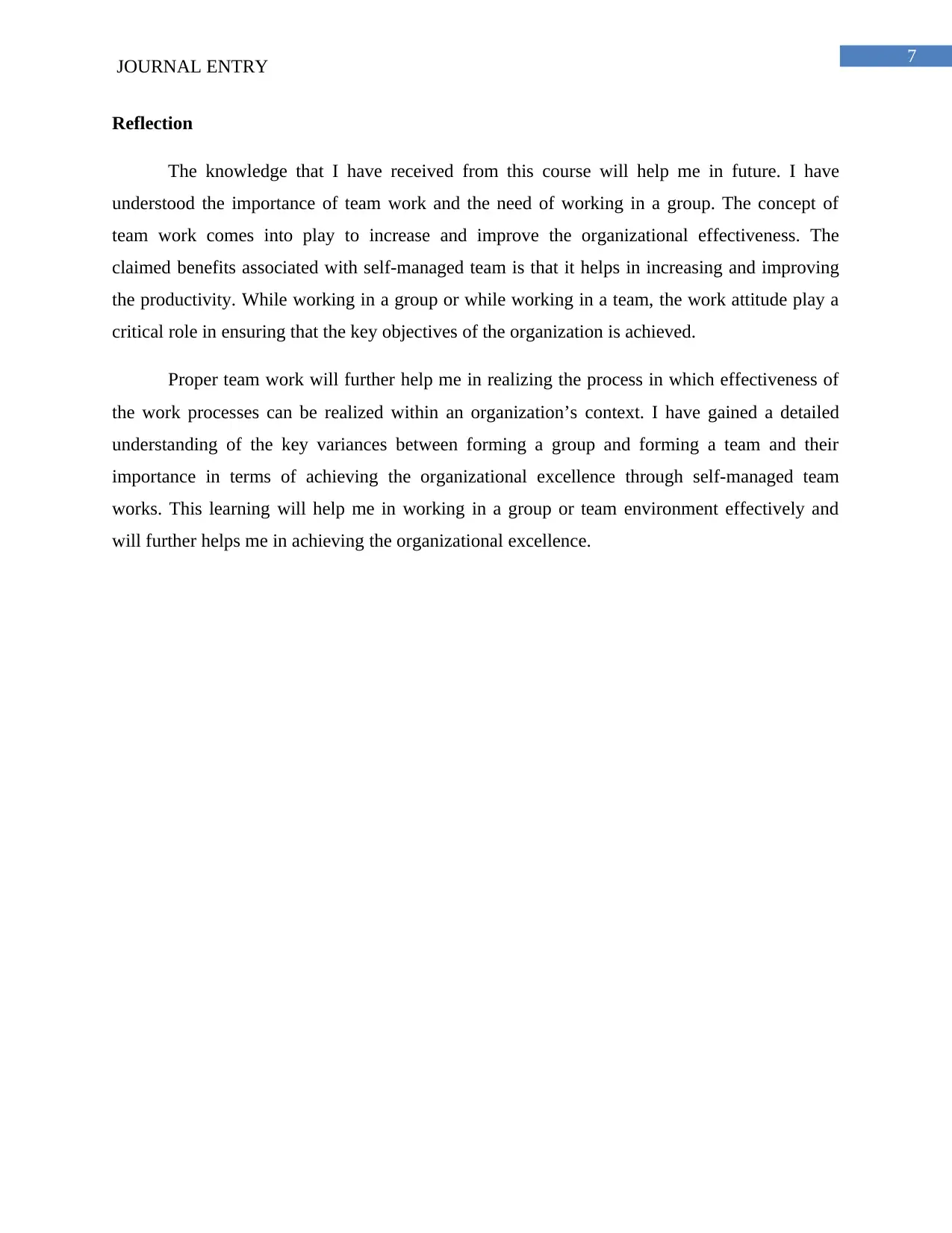
7
JOURNAL ENTRY
Reflection
The knowledge that I have received from this course will help me in future. I have
understood the importance of team work and the need of working in a group. The concept of
team work comes into play to increase and improve the organizational effectiveness. The
claimed benefits associated with self-managed team is that it helps in increasing and improving
the productivity. While working in a group or while working in a team, the work attitude play a
critical role in ensuring that the key objectives of the organization is achieved.
Proper team work will further help me in realizing the process in which effectiveness of
the work processes can be realized within an organization’s context. I have gained a detailed
understanding of the key variances between forming a group and forming a team and their
importance in terms of achieving the organizational excellence through self-managed team
works. This learning will help me in working in a group or team environment effectively and
will further helps me in achieving the organizational excellence.
JOURNAL ENTRY
Reflection
The knowledge that I have received from this course will help me in future. I have
understood the importance of team work and the need of working in a group. The concept of
team work comes into play to increase and improve the organizational effectiveness. The
claimed benefits associated with self-managed team is that it helps in increasing and improving
the productivity. While working in a group or while working in a team, the work attitude play a
critical role in ensuring that the key objectives of the organization is achieved.
Proper team work will further help me in realizing the process in which effectiveness of
the work processes can be realized within an organization’s context. I have gained a detailed
understanding of the key variances between forming a group and forming a team and their
importance in terms of achieving the organizational excellence through self-managed team
works. This learning will help me in working in a group or team environment effectively and
will further helps me in achieving the organizational excellence.
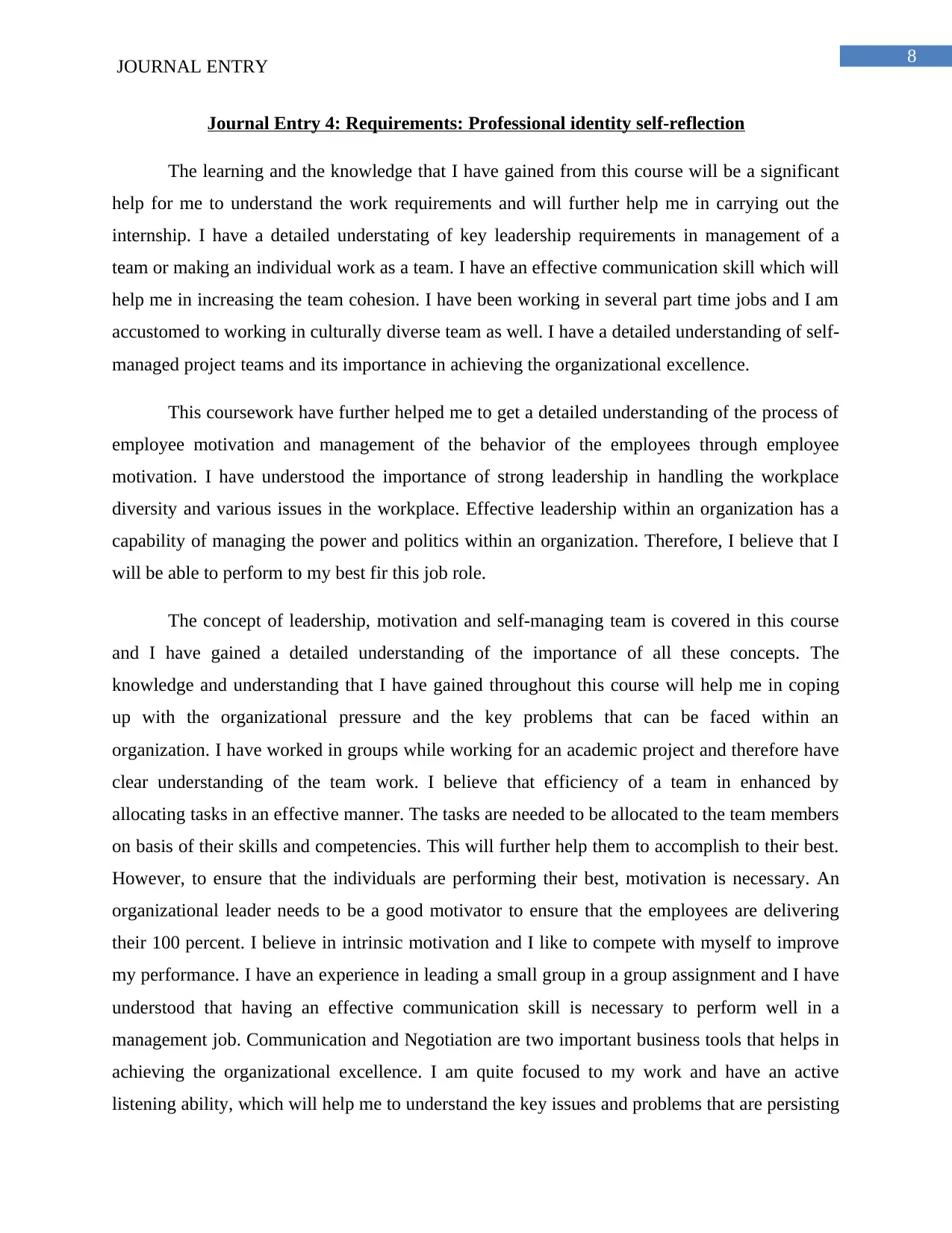
8
JOURNAL ENTRY
Journal Entry 4: Requirements: Professional identity self-reflection
The learning and the knowledge that I have gained from this course will be a significant
help for me to understand the work requirements and will further help me in carrying out the
internship. I have a detailed understating of key leadership requirements in management of a
team or making an individual work as a team. I have an effective communication skill which will
help me in increasing the team cohesion. I have been working in several part time jobs and I am
accustomed to working in culturally diverse team as well. I have a detailed understanding of self-
managed project teams and its importance in achieving the organizational excellence.
This coursework have further helped me to get a detailed understanding of the process of
employee motivation and management of the behavior of the employees through employee
motivation. I have understood the importance of strong leadership in handling the workplace
diversity and various issues in the workplace. Effective leadership within an organization has a
capability of managing the power and politics within an organization. Therefore, I believe that I
will be able to perform to my best fir this job role.
The concept of leadership, motivation and self-managing team is covered in this course
and I have gained a detailed understanding of the importance of all these concepts. The
knowledge and understanding that I have gained throughout this course will help me in coping
up with the organizational pressure and the key problems that can be faced within an
organization. I have worked in groups while working for an academic project and therefore have
clear understanding of the team work. I believe that efficiency of a team in enhanced by
allocating tasks in an effective manner. The tasks are needed to be allocated to the team members
on basis of their skills and competencies. This will further help them to accomplish to their best.
However, to ensure that the individuals are performing their best, motivation is necessary. An
organizational leader needs to be a good motivator to ensure that the employees are delivering
their 100 percent. I believe in intrinsic motivation and I like to compete with myself to improve
my performance. I have an experience in leading a small group in a group assignment and I have
understood that having an effective communication skill is necessary to perform well in a
management job. Communication and Negotiation are two important business tools that helps in
achieving the organizational excellence. I am quite focused to my work and have an active
listening ability, which will help me to understand the key issues and problems that are persisting
JOURNAL ENTRY
Journal Entry 4: Requirements: Professional identity self-reflection
The learning and the knowledge that I have gained from this course will be a significant
help for me to understand the work requirements and will further help me in carrying out the
internship. I have a detailed understating of key leadership requirements in management of a
team or making an individual work as a team. I have an effective communication skill which will
help me in increasing the team cohesion. I have been working in several part time jobs and I am
accustomed to working in culturally diverse team as well. I have a detailed understanding of self-
managed project teams and its importance in achieving the organizational excellence.
This coursework have further helped me to get a detailed understanding of the process of
employee motivation and management of the behavior of the employees through employee
motivation. I have understood the importance of strong leadership in handling the workplace
diversity and various issues in the workplace. Effective leadership within an organization has a
capability of managing the power and politics within an organization. Therefore, I believe that I
will be able to perform to my best fir this job role.
The concept of leadership, motivation and self-managing team is covered in this course
and I have gained a detailed understanding of the importance of all these concepts. The
knowledge and understanding that I have gained throughout this course will help me in coping
up with the organizational pressure and the key problems that can be faced within an
organization. I have worked in groups while working for an academic project and therefore have
clear understanding of the team work. I believe that efficiency of a team in enhanced by
allocating tasks in an effective manner. The tasks are needed to be allocated to the team members
on basis of their skills and competencies. This will further help them to accomplish to their best.
However, to ensure that the individuals are performing their best, motivation is necessary. An
organizational leader needs to be a good motivator to ensure that the employees are delivering
their 100 percent. I believe in intrinsic motivation and I like to compete with myself to improve
my performance. I have an experience in leading a small group in a group assignment and I have
understood that having an effective communication skill is necessary to perform well in a
management job. Communication and Negotiation are two important business tools that helps in
achieving the organizational excellence. I am quite focused to my work and have an active
listening ability, which will help me to understand the key issues and problems that are persisting
⊘ This is a preview!⊘
Do you want full access?
Subscribe today to unlock all pages.

Trusted by 1+ million students worldwide
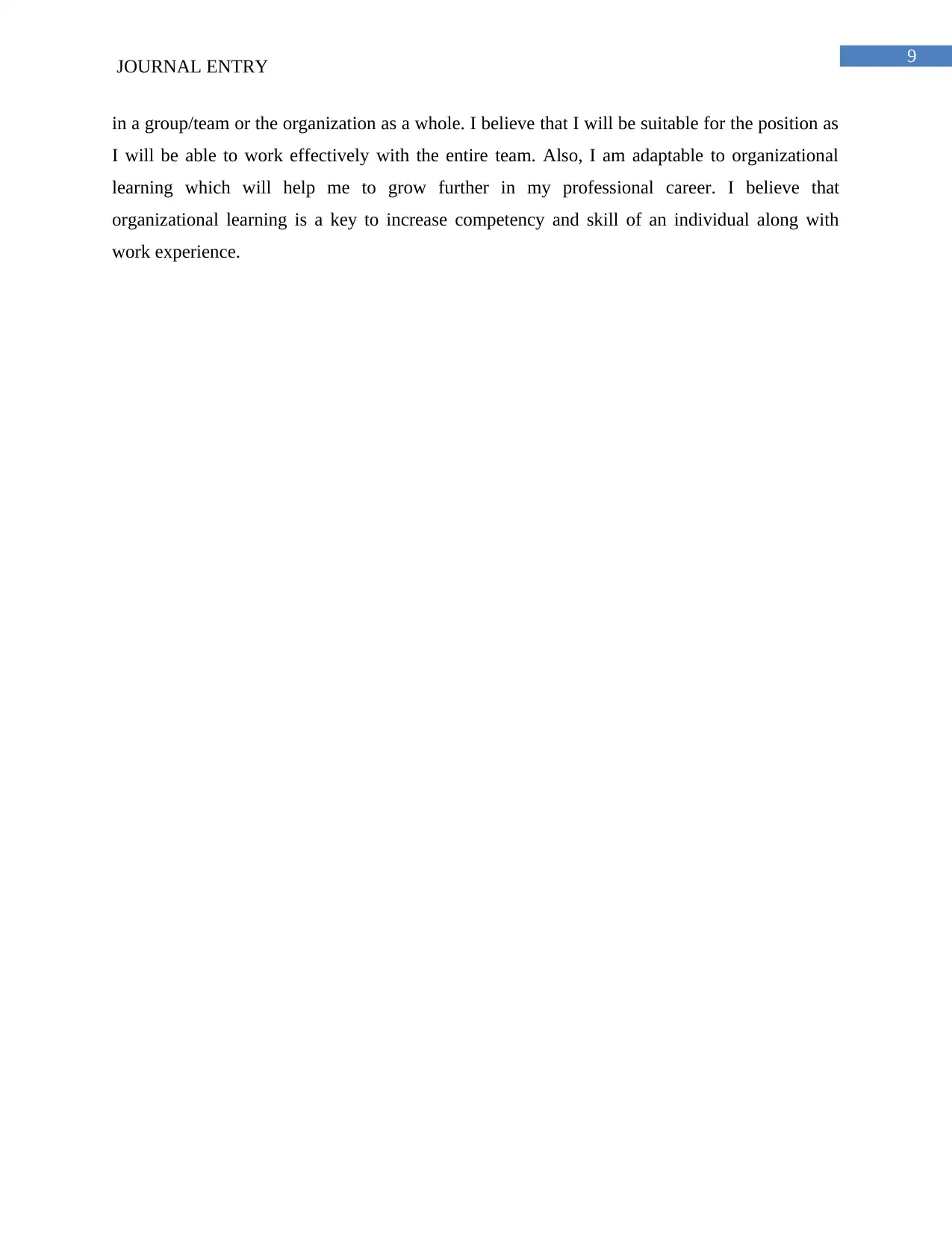
9
JOURNAL ENTRY
in a group/team or the organization as a whole. I believe that I will be suitable for the position as
I will be able to work effectively with the entire team. Also, I am adaptable to organizational
learning which will help me to grow further in my professional career. I believe that
organizational learning is a key to increase competency and skill of an individual along with
work experience.
JOURNAL ENTRY
in a group/team or the organization as a whole. I believe that I will be suitable for the position as
I will be able to work effectively with the entire team. Also, I am adaptable to organizational
learning which will help me to grow further in my professional career. I believe that
organizational learning is a key to increase competency and skill of an individual along with
work experience.
Paraphrase This Document
Need a fresh take? Get an instant paraphrase of this document with our AI Paraphraser
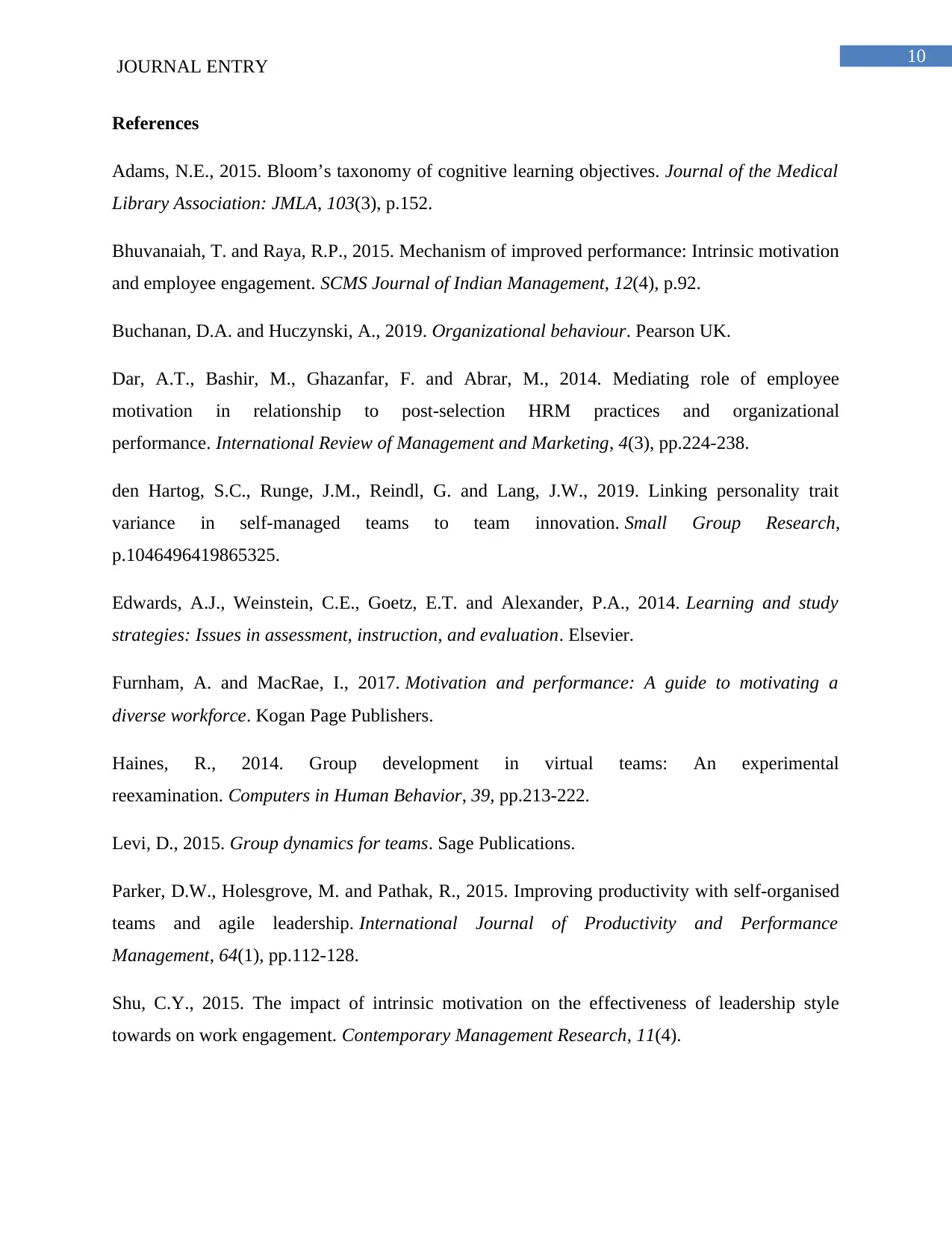
10
JOURNAL ENTRY
References
Adams, N.E., 2015. Bloom’s taxonomy of cognitive learning objectives. Journal of the Medical
Library Association: JMLA, 103(3), p.152.
Bhuvanaiah, T. and Raya, R.P., 2015. Mechanism of improved performance: Intrinsic motivation
and employee engagement. SCMS Journal of Indian Management, 12(4), p.92.
Buchanan, D.A. and Huczynski, A., 2019. Organizational behaviour. Pearson UK.
Dar, A.T., Bashir, M., Ghazanfar, F. and Abrar, M., 2014. Mediating role of employee
motivation in relationship to post-selection HRM practices and organizational
performance. International Review of Management and Marketing, 4(3), pp.224-238.
den Hartog, S.C., Runge, J.M., Reindl, G. and Lang, J.W., 2019. Linking personality trait
variance in self-managed teams to team innovation. Small Group Research,
p.1046496419865325.
Edwards, A.J., Weinstein, C.E., Goetz, E.T. and Alexander, P.A., 2014. Learning and study
strategies: Issues in assessment, instruction, and evaluation. Elsevier.
Furnham, A. and MacRae, I., 2017. Motivation and performance: A guide to motivating a
diverse workforce. Kogan Page Publishers.
Haines, R., 2014. Group development in virtual teams: An experimental
reexamination. Computers in Human Behavior, 39, pp.213-222.
Levi, D., 2015. Group dynamics for teams. Sage Publications.
Parker, D.W., Holesgrove, M. and Pathak, R., 2015. Improving productivity with self-organised
teams and agile leadership. International Journal of Productivity and Performance
Management, 64(1), pp.112-128.
Shu, C.Y., 2015. The impact of intrinsic motivation on the effectiveness of leadership style
towards on work engagement. Contemporary Management Research, 11(4).
JOURNAL ENTRY
References
Adams, N.E., 2015. Bloom’s taxonomy of cognitive learning objectives. Journal of the Medical
Library Association: JMLA, 103(3), p.152.
Bhuvanaiah, T. and Raya, R.P., 2015. Mechanism of improved performance: Intrinsic motivation
and employee engagement. SCMS Journal of Indian Management, 12(4), p.92.
Buchanan, D.A. and Huczynski, A., 2019. Organizational behaviour. Pearson UK.
Dar, A.T., Bashir, M., Ghazanfar, F. and Abrar, M., 2014. Mediating role of employee
motivation in relationship to post-selection HRM practices and organizational
performance. International Review of Management and Marketing, 4(3), pp.224-238.
den Hartog, S.C., Runge, J.M., Reindl, G. and Lang, J.W., 2019. Linking personality trait
variance in self-managed teams to team innovation. Small Group Research,
p.1046496419865325.
Edwards, A.J., Weinstein, C.E., Goetz, E.T. and Alexander, P.A., 2014. Learning and study
strategies: Issues in assessment, instruction, and evaluation. Elsevier.
Furnham, A. and MacRae, I., 2017. Motivation and performance: A guide to motivating a
diverse workforce. Kogan Page Publishers.
Haines, R., 2014. Group development in virtual teams: An experimental
reexamination. Computers in Human Behavior, 39, pp.213-222.
Levi, D., 2015. Group dynamics for teams. Sage Publications.
Parker, D.W., Holesgrove, M. and Pathak, R., 2015. Improving productivity with self-organised
teams and agile leadership. International Journal of Productivity and Performance
Management, 64(1), pp.112-128.
Shu, C.Y., 2015. The impact of intrinsic motivation on the effectiveness of leadership style
towards on work engagement. Contemporary Management Research, 11(4).
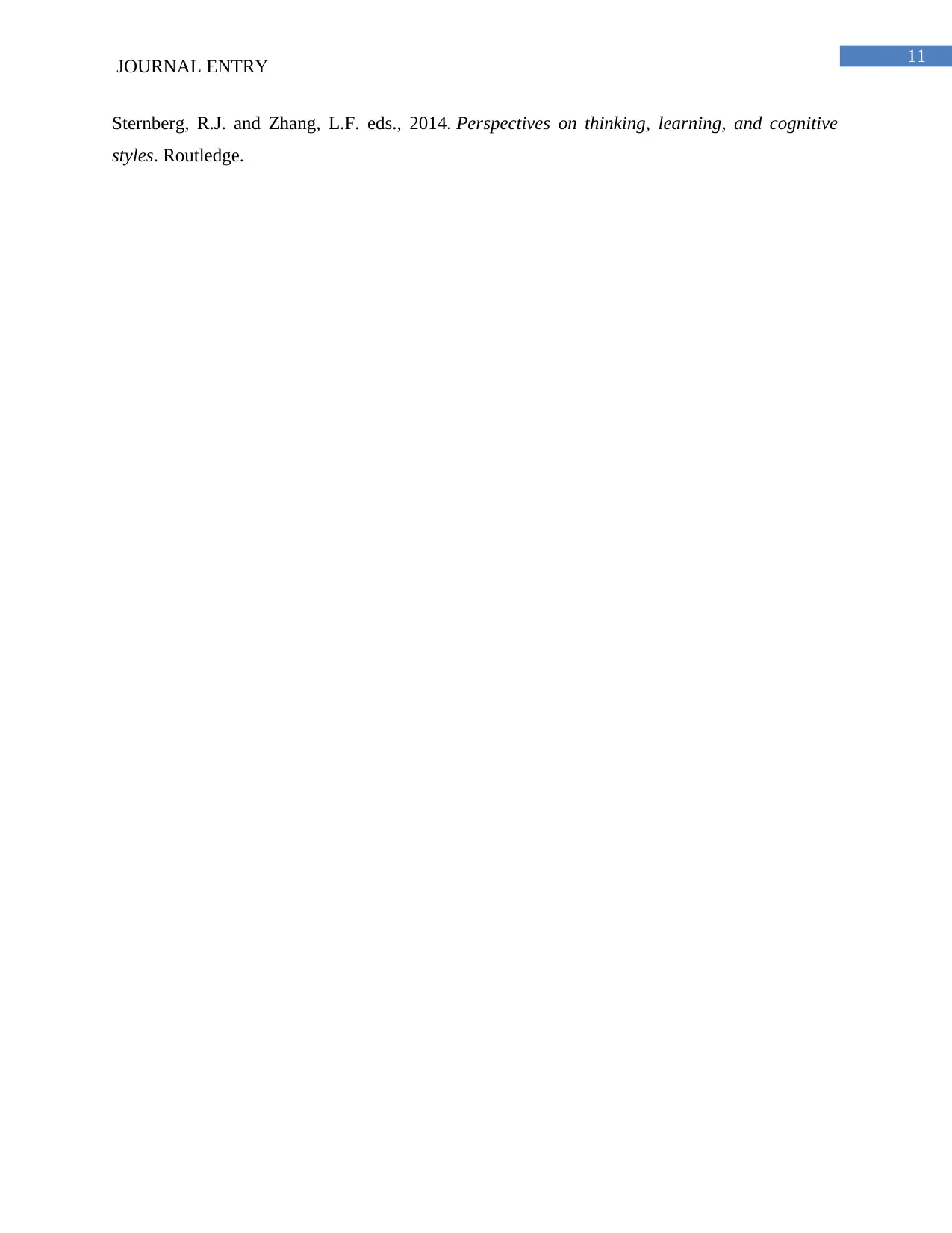
11
JOURNAL ENTRY
Sternberg, R.J. and Zhang, L.F. eds., 2014. Perspectives on thinking, learning, and cognitive
styles. Routledge.
JOURNAL ENTRY
Sternberg, R.J. and Zhang, L.F. eds., 2014. Perspectives on thinking, learning, and cognitive
styles. Routledge.
⊘ This is a preview!⊘
Do you want full access?
Subscribe today to unlock all pages.

Trusted by 1+ million students worldwide
1 out of 12
Related Documents
Your All-in-One AI-Powered Toolkit for Academic Success.
+13062052269
info@desklib.com
Available 24*7 on WhatsApp / Email
![[object Object]](/_next/static/media/star-bottom.7253800d.svg)
Unlock your academic potential
Copyright © 2020–2025 A2Z Services. All Rights Reserved. Developed and managed by ZUCOL.





